Posted
on 12:04 PM
in Hiroko's Blog
CHEFS! Apply now for the Washoku World Challenge competition https://www.washoku-worldchallenge.maff.go.jp/10th/en/index.html to test your Japanese cooking skills. The finalists in different region are invited to compete in Japan.
Send me any questions you might have.
Hiroko
Posted
on 7:04 PM
in Hiroko's Blog
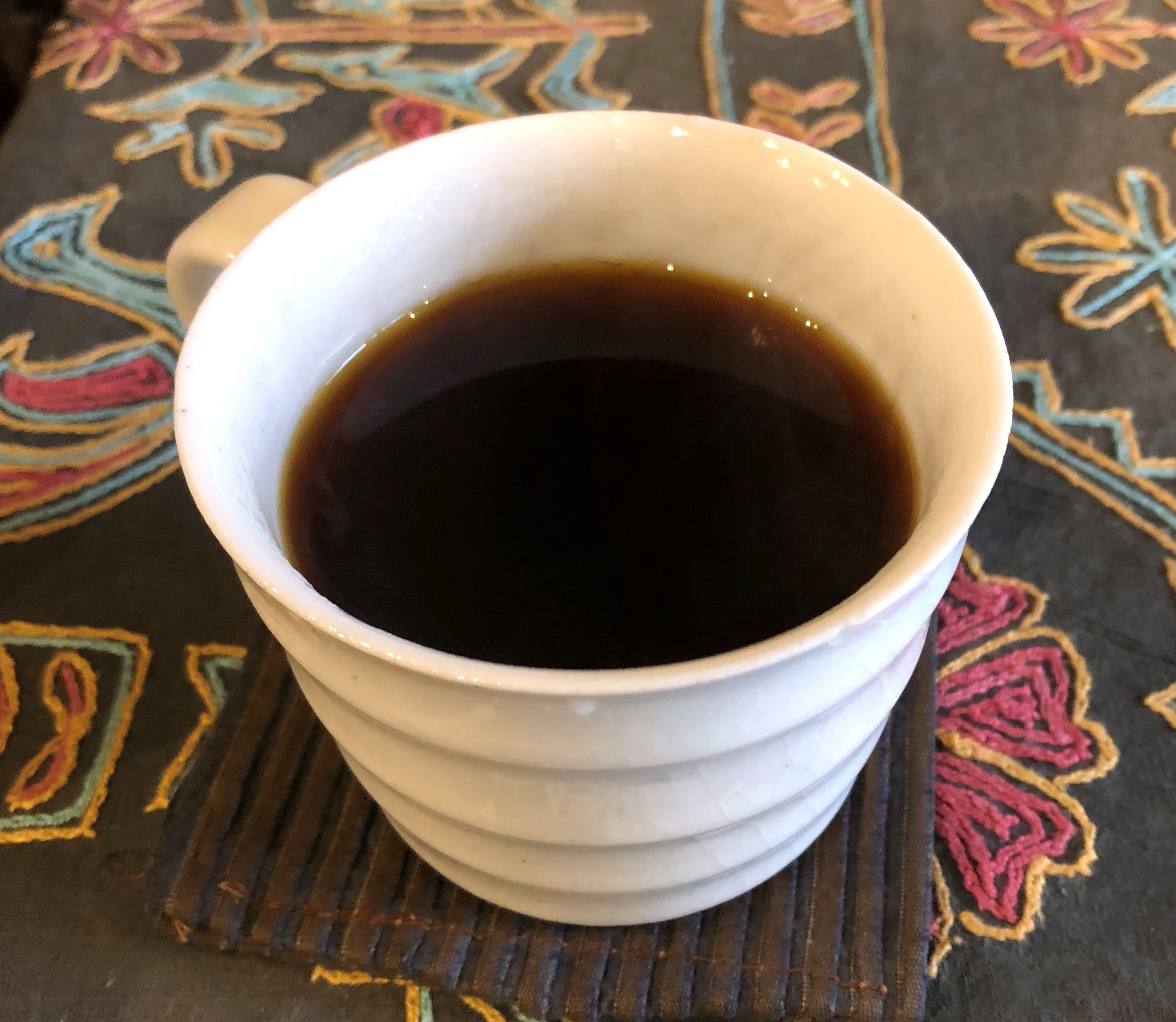
New Coffee Experience
I love cooking meat and fish over a Japanese bincho-tan charcoal fire. I know what this particular charcoal fire does in cooking. For example, when I cook pork chop over exposed bincho-tan charcoal fire, infrared ray, which is emitted from the bincho-tan charcoal fire, permeates into the center of pork chop, thus cooked meat has even texture, and is juicy and moist. A Japanese tea expert and a good friend of mine, Kei Nishida, sent me three sample bags of bincho-tan roasted coffee beans for me to try. According to him Kei added a coffee been business to his existing tea business. He is excited about introducing bincho-tan roasted coffee beans for the first time to his customers in USA.
Sumibi Baisen, is the Japanese name for coffee beans roasted using bincho-tan charcoal fire. The end of Edo period, 1868, is the year when the coffee beans are for the first time officially introduced to Japan. Coffee has already 150 years history in Japan. Roasting coffee beans using bincho-tan goes back to 1920s, 52 years after the introduction. Bincho-tan was used because it was easily available heat source. After gas roaster’s introduction, many coffee beans roaster switched to this new method, because of great efficiency of roasting beans. One of the companies, Hagiwara Coffee Company in Kobe City, which began using bincho-tan in 1928, still sticks to this old bincho-tan roasting method. By using bincho-tan method the beans are roasted uniformly; the roasting brings out the best and rich flavor of beans. These characteristics have been capturing the soul of Japanese coffee aficionado. Kei Nishida is one of them.
I have tasted Colombia single origin, Indonesia single origin and Organic blend. I have ruined the coffee at the first tasting session. I did not follow any guidelines for brewing the best tasting coffee. The water was too hot; I ground beans too fine; the proportion of beans and water weight was wrong; I did not wet the coffee filter with hot water in advance; I did not time and weight at the time of pouring hot water over the ground beans. The coffee tasted extremely bitter….!
I learned how to properly brew coffee, including how much we should grind beans, from these young professionals. Daiki Hatakeyama and Hidenori Izaki; both are award winning coffee experts in Japan. https://www.youtube.com/watch?v=HwIIVTAIQag, https://www.youtube.com/watch?v=o3eMg4DYLKo
Here are the guidelines of brewing good tasting coffee.
- Use 6 – 8g coffee beans for 100g water. (You need an electric scale!)
- Grind coffee beans medium rough. For my coffee beans I process the beans in the grinder only for 7 seconds. If I go more, the bitterness comes out into my brew.
- Suggested water temperature to brew coffee is 85-degree C.
- Wet the coffee filter paper and warm the paper holder with hot water.
- Pour water in 3 stages: First: 20%, Second 20%, Third 60%
- Brewing coffee time is about 3 minutes
Second Sumibi Baisen coffee tasting proved me that wrong brewing process completely destroy the flavor of excellent coffee beans. This time every coffee tasted had a round, rich and delicious flavor. Indonesian beans had a touch of unnecessary bitterness for me. I loved the organic one the best.
Nespresso was finally introduced to the Japanese market in December, 2020. I hope that this coffee machine does not ruin the long nurtured and cherished rich history of making coffee manually at home. Try Sumibi Baisen coffee at your home. It will certainly expand the pleasure of making and enjoying coffee at home.
https://japanesecoffeeco.com/pages/our-story
Posted
on 12:31 PM
in Hiroko's Blog
 Last week I Co-hosted with Ezra Star, a Cognac Expert, “Roll with Cognac”, educational webinar, for journalists. Pairing Cognac and Sushi – how fun and cool it was!
Last week I Co-hosted with Ezra Star, a Cognac Expert, “Roll with Cognac”, educational webinar, for journalists. Pairing Cognac and Sushi – how fun and cool it was!
Both Cognac and Sushi are examples of highly refined culinary arts. Cognac and Sushi shares similar history and characteristics in many ways. Both are adopted from foreign culinary culture. Cognac’s origin lies in the 16th century with the arrival of Dutch in France. Preliminary forms of sushi arrived in Japan from China in early centuries. These adopted children are respectively taken care of by the people of France and Japan. Both have matured and became two of the most celebrated food products in the world.
Cognac and Sushi bring to mind high quality, artisan skills, tradition and excellence. As Cognac production maintains strict rules for its making, crafting sushi, in this case I mean nigiri-zushi – the sushi that is a block of rice topped with a slice of seafood – also obeys and follows guidelines in order to serve raw fish safely and deliciously for consumption.
For this Webinar I chose particular fish for each Cognac to pair. Remember that sushi is composed of sushi rice, a slice of seafood, tiny amount of wasabi and soy sauce. Each of this element has its own flavor, and as a sushi piece it has five distinctive flavor characteristics. The reason for the particular choice of fish for each sushi is to properly balance the five flavor components of sushi and the four flavors of Cognac. By doing so we can create the best gastronomic experience.
Hit the click and watch ‘Roll with Cognac’! https://cognacconnection.com/virtual-events/2021/2/10/roll-with-cognac
By the way I am not a hard liquor drinker. I have tasted Cognac (just sipping to taste it) only few times in my entire life. For this Webinar I was exposed to five different kinds. I sipped little bit of each at a time over a week in order to find the best nigirizushi pair. Two VS, one VSOP and two XO. I was amazed to find delightful characters in each Cognac, both young and aged.
Cognac and sushi pairs very well from the point of how we enjoy them. We pop into our mouth a small nigirizushi at a time. We take time to enjoy the flavor of it using our all five senses. Sipping a little Cognac in between this is ideal. Cognac enhances sushi flavor in our mouth, but not washing it away.
Roll with Cognac!!!
Hiroko
Posted
on 1:30 PM
in Hiroko's Blog
I would like to share with you the conversation with my dear friend Dara Bunjon. She host programs on Jmoreliving.com; https://jmoreliving.com/2021/02/04/the-food-enthusiast-with-guest-hiroko-shimbo/
Dara, thank you very much for having me at your station. Years have passed but you have such a good memory on our encounter. When the good time comes back, I look forward to having an in-person conversation with you.
Thank you again,
Hiroko
Posted
on 2:42 PM
in Hiroko's Blog
Miso: Traditional Flavors with Modern Application – The Fermentation Association
This is a clip from the Miso Webinar which I participated on January 21st. Now I know how messy my presentation during close-up time was. The papers with miso names move around and was placed not neatly ….Ugh! Kristin’s presentation and Kyle’s super beautiful presentation are a must to watch.
Hope you enjoy mine as well!
Hiroko
Posted
on 1:23 PM
in Hiroko's Blog
@japanesecuisineauthority (Instagram)
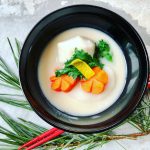
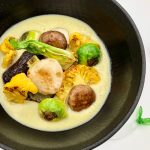
Hi this is Hiroko Shimbo. Among many questions asked to us at the Miso Webinar I recently participated with Robert, Kristen and Kyle for The Fermentation Association; this one caught my attention. “Why miso is produced only from soybeans many times with a few other grains added, but until very recently never using other beans?”
In order to answer this question, let me take you to the very early days of Japan. Preliminary forms of both miso and shoyu (soy sauce) called jiang were developed in China back about 1,000 BC. Jiang are the fermented and/or salt cured condiments made from various ingredients, including vegetables, legumes, seafood and meat. Varieties of jiang were introduced to the Imperial Court of Japan in Kyoto, and grain-based jiang, which became shoyu and miso, was adopted as a condiment by the Imperial Court. This reflects the introduction of Buddhism to Japan and the order prohibiting meat-eating issued by Emperor Tenmu in 675 AD.
A primitive form of miso, called Misho was soon developed as a Japanese-developed “take” on jiang. In the book of Yoryo Ritsuryo, Codes of the Political System, compiled in 718 AD it is mentioned that the Imperial Court government created a culinary department responsible for securing ingredients and preparing meals for the Imperial Court. Within that organization there was a position for the person who oversees the production of Misho at the Imperial Court. The listed ingredients used to make Misho are found in this same old book. They are soybeans, salt, sake, koji, glutinous rice and wheat. The description of the production process itself is not, however, contained in the book.
Misho, which is made from soybeans, was an ideal source of protein for people whose diet was limited to vegetables with the supplement of seafood caught along the coast. In Japan soybeans have been called ‘field meat’ because of the large amount of high-quality protein and other important nutrients it contains. Somehow this became known to ancient people who had no modern knowledge of nutrition.
Misho was developed into the closest form of present-day miso by around 13th century. It is said that it was enjoyed as a snack over a cup of sake but was not used in the preparation of miso soup. During the 15th and 16th centuries, the era of Japan’s Civil War miso became an important military ration because it provided quality protein and other nutrients to the fighting soldiers. Thus, feudal lords in each region across the country began making their own local miso. Among them the Sendai miso made in Miyagi Prefecture which I introduced you at the Webinar, became the most sought-after miso by other feudal lords. The reason being that Sendai miso did not spoil quickly.
From these historical facts, now we know why miso is made from soybeans and why there is so much regional variation among miso. Today our diet has become very rich in protein and miso is no longer needed as an important dietary source of good, high-quality, digestible proteins. Thus, without the nutritional need for soybeans as a source of protein, we can now enjoy miso made from other varieties of beans.
On March 26, 2021 (12:00PM PST/ 3PM EST) I will teach “Home-made Sweet White Miso”. After taking this class, in your own kitchen with readily available materials you can easily make your own delicious and real home-made miso. As always, when you make something yourself with simple ingredients, you know what is in it and how it is made. The result is delicious, nutritious, free from chemical additives and factory processing. In addition to our miso is alive! You will also learn much more about this wonderful food — it’s not just for miso soup anymore!
Please join me on March 26,2021 and learn more about this wonderful food products. Visit my Website and sign up for my Zoom class at: https://hirokoskitchen.com/classes-and-culinary-tours/
I will see you there!
I will be posting some answers to other questions we received at the Miso Webinar. So, check my Website for these posts sometime later. You will also find ideas for using miso and information on a variety of Japanese dish ideas at my Instagram: Japanesecuisineauthority. Have a look, get some miso, cook and enjoy the results. Also, you can find many delicious recipes in Hiroko’s American Kitchen. https://hirokoskitchen.com/shop/hirokos-american-kitchen/
Have fun!!
Finally, join me this November to Kyushu Island of Japan. https://hirokoskitchen.com/kyushu-premium/
This is one of a life time experience in Japan who loves Japanese culture, food, food production, nature, art, history and people. Please take a look at whole tour information here. Please sign up early before all places are taken. I am taking only 9 enthusiastic travelers on this exclusive, fun and memorable tour!
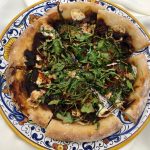
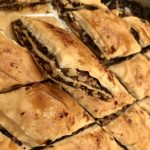

Thank you!
Hiroko
Posted
on 8:33 PM
in Hiroko's Blog
HAPPY NEW YEAR, THE BEST BEEF YOU EVER TASTED, AN AMAZING TOUR
I wish that all of your family members, friends and colleagues are safe and healthy in 2021. We are in history at a key moment. We see so many suffering in society. We hope the herd immunity will happen by early fall in 2021, and we can resume life the way we enjoyed it in the past but with much more appreciation.
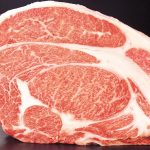
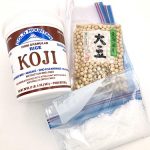 The year 2021 begins a new chapter in my teaching career. I will be offering cooking classes over Zoom starting in February 2021. Please have a look what I am offering and join me to learn how to prepare Japanese dishes both comfort food and more challenging ones with ease and fun. You will not just learn the recipe of the dish. You will learn techniques, preparation tips, personal anecdotes, interesting stories and the history of the dishes. The first session introduces you to and provides you with the absolute best wagyu beef from Japan and instruction in how to prepare it with accompanying dishes and to the fascinating process of making and using your own miso.
The year 2021 begins a new chapter in my teaching career. I will be offering cooking classes over Zoom starting in February 2021. Please have a look what I am offering and join me to learn how to prepare Japanese dishes both comfort food and more challenging ones with ease and fun. You will not just learn the recipe of the dish. You will learn techniques, preparation tips, personal anecdotes, interesting stories and the history of the dishes. The first session introduces you to and provides you with the absolute best wagyu beef from Japan and instruction in how to prepare it with accompanying dishes and to the fascinating process of making and using your own miso.
Click here. This is my Zoom class link on my website. https://hirokoskitchen.com/classes-and-culinary-tours/
Also check out my amazing KYUSHU PREMIUM 2021 tour. This unique tour in Japan is in its third year of providing a once-in-a-lifetime cultural, culinary and enlightening experience in the most fascinating region of the country. Register now for a no-obligation chance to join the group which is limited to only 10 participants. This preliminary step will ensure your eligibility to join when the application is available in Spring 2021
Click here for information on KYUSHU PREMIUM 2021 on my website https://hirokoskitchen.com/kyushu-premium/
Looking forward to seeing you at Zoom Class and in the Tour!!!
Best regards,
Hiroko
Posted
on 2:35 PM
in Hiroko's Blog
ANNOUNCEMENT, ABOUT KYUSHU & KYUSHU PREMIUM AND ITINERARY
This is the third Kyushu tour to be offered and conducted by Hiroko; This exclusive tour takes place in Kyushu, one of the most fascinating and important regions of Japan in matters of cuisine, foreign influence and history and geology. If you have been to Japan previously and perhaps experienced Tokyo and Kyoto, you will find the Kyushu experience enlightening, fascinating and, above all, enjoyable. If this is your first time in Japan, Kyushu provide the best historical and cultural introduction to the country.
This is one of many of such reviews from the attendees of KYUSHU PREMIUM 2019.
This trip exceeded all of our expectations! We most enjoyed going to the mountainous and rural areas of Kyushu. We were happy to be where most tourists don’t go. You introduced us not only to great Japanese cuisine in so many forms, but also to the Japanese people and their culture. It was a bonus to hike and to be close to nature on many of our outings. You have a special way of being organized and keeping the schedule, while allowing everyone to enjoy the experiences. Kyushu Premium was a trip of a lifetime! A&G
KYUSHU PREMIUM is available to a small group tour of up to 10 people. The tour offers you the richest experiences in all aspects of Kyushu – activities, dining, accommodations and human contacts with the locals. Hiroko’s well researched knowledge and relationships in the region introduces the region and entertains all of your five senses throughout the experience. Today traveling in a foreign country, such as Japan, has become a lot easier with advanced technology, but KYUSHU PREMIUM explores areas that are not accessible to technology alone. It is all about the human relationships Hiroko has cultivated that makes KYUSHU PREMIUM so unique, memorable and enjoyable.
ABOUT KYUSHU & KYUSHU PREMIUM
Kyushu, the southernmost large island of Japan, is chockfull of incredible interests of so many kinds. I had visited Kyushu in past years on business. During such trips I didn’t experience what inquisitive and interested visitors can do in Kyushu, so I had little idea of the huge variety of amazing sights and experiences Kyushu can offer to us. In 2017 I decided to make Kyushu the next destination for my annual tour to Japan. Thus, was born the initial idea for KYUSHU PREMIUM 2018. Since making that decision I have deeply studied the history, culture, natural environment, onsen hot springs, geology, food, art and people of Kyushu. Then, I carefully picked the places, each of which highlights the unique characteristics of Kyushu. In December 2017 I made this circuit on my own to absolutely confirm my expectations for the tour. This tour plan is the result of my study and exploration.
Some of you may have heard these Japanese culinary words: kabocha (squash), kara-age (a deep-frying method without batter), tempura (deep-frying method with batter), chawan’mushi (savory egg custard), kasutera (pound cake) just to name a few. These words describe foods and cooking techniques brought from abroad to Kyushu, reflecting the rich history of foreign influence in just the one area of culinary arts that extends back nearly 1500 years. This unique history of foreign influences and interactions is a major part of the fascination of Kyushu. It is very different from that experienced in the usual more familiar tourist precincts of Tokyo, Osaka, Kyoto, Kanazawa and Takayama.
Kyushu sits close to China and Southeast Asia. It was, therefore, the window for the introduction to Japan of Asian culture and religion in the earliest years of the first millennium. Kyushu is also the closest sea access to Europe, and it became the window to European civilization, including Christianity, beginning in the early 16th century. The strong influences of these early international contacts remain present everywhere in the island and its culture to this day. We will see and experience them on this tour.
Kyushu is well known as hot spring heaven in Japan due to its unique geology at the intersection of two tectonic plates. Active volcanoes, Mt. Aso and Mt. Sakurajima, tell the history of the changing natural and geographic environment of Kyushu. Both beneficial and the causes of disaster, these volcanoes determine much of Kyushu’s human and natural history. A particular consequence of their presence is natural glory found throughout the island.
Kyushu’s Christian history is a story of introduction, prosperity, suppression, persecution and rebirth. We will see this miracle first-hand and explore this complex story at many locations and from many perspectives. What happened in Kyushu is unique in world history.
At this particular time when we live with growing international tensions visiting the Nagasaki Atomic Peace Park and Museum will remind us of the horror of atomic weapons and the need for maintaining world peace to preclude their use.
You may know that for 250 years beginning in the 17th century Japan was closed to the outside world with only the Dutch occupying a tiny island, Dejima (“separated island”), just off Nagasaki. That island compound has been faithfully recreated. It is not Disneyland, but is a living, fascinating and accessible historical site replete with Japanese and Dutch history.
A foundation of Japanese cuisine is dashi stock which is made by infusing kombu (kelp) and katsuobushi (skipjack tuna) flakes. Katsuobushi comes from the town of Makurazaki in Kyushu. A visit to a factory that produces this indispensable material will reveal the fascinating traditional, artisanal production of katsuobushi. Without seeing this, you cannot say that you know Japanese cuisine.
An equally fascinating and delicious product of Kyushu is shochu, the distilled liquor made variously from rice, barley, sweet potato, potato, brown sugar and more. During the tour we will taste different varieties of shochu as we move from one area to another; the tour will make you a shochu expert.
Please enjoy the itinerary described in this package and join me on KYUSHU PREMIUM 2021; fascinating, educational, fun, active and delicious tour to Kyushu! I look forward to experiencing all of the sights and activities described in this document with you in Kyushu.
Please review the itinerary described in the accompanying document. Tariff and Application Form information will be available in late January, 2021.
KYUSHU PREMIUM 2021 ITINERARY: Nov.3-15
November 3, Wednesday
Check in yourself at the Haneda Excel Hotel, Tokyo. The room is booked for you. Join Hiroko at 8:30PM for an after-dinner coffee/tea orientation at HOSHI room at FLYER’S TABLE restaurant in the hotel.
November 4, Thursday
 We take an early morning flight to Oita Airport. We visit Kunisaki Peninsula, located in the northeast area of Kyushu, which is known for ancient, unique Buddhist culture. We participate in-a-once-in-a-life time Buddhist ritual service at Monju-Senji Temple, which was founded in 648 AD. The priest, tending a large ritual fire, prays for our health, family happiness and good weather & safe journey through out our tour. We stop at the Tennenji Temple, hike and admire Magaibutsu, Buddha sculptures carved into the rock cliff. We head to Beppu, one of the most famous hot spring towns in Japan for one-night stay. We enjoy fugu (blowfish) specialty dinner at 100 years old establishment in the town.
We take an early morning flight to Oita Airport. We visit Kunisaki Peninsula, located in the northeast area of Kyushu, which is known for ancient, unique Buddhist culture. We participate in-a-once-in-a-life time Buddhist ritual service at Monju-Senji Temple, which was founded in 648 AD. The priest, tending a large ritual fire, prays for our health, family happiness and good weather & safe journey through out our tour. We stop at the Tennenji Temple, hike and admire Magaibutsu, Buddha sculptures carved into the rock cliff. We head to Beppu, one of the most famous hot spring towns in Japan for one-night stay. We enjoy fugu (blowfish) specialty dinner at 100 years old establishment in the town.
November 5, Friday

 Today we head to 290 years old Kurokawa Onsen, a hot spring town that has 30 traditional Japanese inns, equipped with rotenburo (outdoor hot spring), scattered deeply in natural beauty alongside the Tanohata River. We stop at Kokonoe Yume Otsurihashi, the highest suspention bridge only for walkway built in in 2006. The beautiful nature is 360 degree view. After arriving we experience Outdoor Onsen-Hopping. We also enjoy local specialty Sake/Shochu-Hopping. The charming inn which we stay for two nights is closed for our group. We enjoy meals prepared with local ingredients.
Today we head to 290 years old Kurokawa Onsen, a hot spring town that has 30 traditional Japanese inns, equipped with rotenburo (outdoor hot spring), scattered deeply in natural beauty alongside the Tanohata River. We stop at Kokonoe Yume Otsurihashi, the highest suspention bridge only for walkway built in in 2006. The beautiful nature is 360 degree view. After arriving we experience Outdoor Onsen-Hopping. We also enjoy local specialty Sake/Shochu-Hopping. The charming inn which we stay for two nights is closed for our group. We enjoy meals prepared with local ingredients.
November 6, Saturday
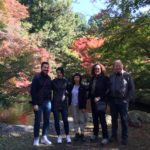
Autumn is in full swing in the country
Today we fully admire the beauty of the nature in autumn in this region. In the morning we visit the prime viewpoint of Aso, from here dramatic 360-degree views reveal panoramic expanse of the whole caldera and the rolling grasslands behind. We continue to Mazeno Gorge, nature reserve, to enjoy the best autumn colors. After lunch we visit 88 years old local sake brewery, Kawazu Shuzo, and learn how sake is made and do sake tastings. After returning to our inn enjoy the outdoor onsen. You may revisit the Outdoor Onsen-Hopping & Sake/Shochu-Hopping if you haven’t completed it the day before.
November 7, Sunday

Hike at Aso cardera; climbing up high gave us a beautiful view
Today we visit Aso caldera. Aso volcano is a cluster of volcanoes situated within a huge caldera that is 25km (15miles) north-to-south and 18km (11miles) east-to-west. Its history extends back nearly 300,000 years consisting of complex volcanic activities and mountain growth. The area is part of the Aso National Park known for its beauty and grandeur. We visit the Aso Museum and watch a video to learn how the Aso caldera was created. This is followed by a climb up Kijima-dake providing awesome views across the entire Aso caldera. After lunch our coach takes us south to historical town of Hitoyoshi where we stay one night.
November 8, Monday
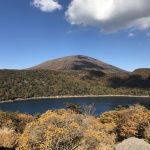 This morning at the historic town of Hitoyoshi we take a man-poled boat ride down the Kuma River, which boasts of having the 2nd most rapid current in Japan. The same ride in the same kind of craft the local Daimyo, Aira, took in feudal days to go down-river in order to begin his biannual trip to Edo (present Tokyo) to pay his respects and tribute to the Shogun. After lunch our coach takes us to Onami-Ike, a beautiful crater lake which stands at 1,411 meters (4,500 feet) above sea level. Onami-Ike Crater Lake was the product of a volcano eruption about 40,000 years ago. The water is cobalt blue. We enjoy walking on a trail through the woods to the top of the Onami-Ike to admire the beautiful lake. After the walk we head to two nights stay at a new, relaxing accommodation.
This morning at the historic town of Hitoyoshi we take a man-poled boat ride down the Kuma River, which boasts of having the 2nd most rapid current in Japan. The same ride in the same kind of craft the local Daimyo, Aira, took in feudal days to go down-river in order to begin his biannual trip to Edo (present Tokyo) to pay his respects and tribute to the Shogun. After lunch our coach takes us to Onami-Ike, a beautiful crater lake which stands at 1,411 meters (4,500 feet) above sea level. Onami-Ike Crater Lake was the product of a volcano eruption about 40,000 years ago. The water is cobalt blue. We enjoy walking on a trail through the woods to the top of the Onami-Ike to admire the beautiful lake. After the walk we head to two nights stay at a new, relaxing accommodation.
November 9, Tuesday

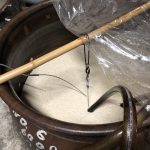 Today we head down to the prefecture where the most indispensable Japanese food product is produced. It is katsuobushi (stone-hard, dried, smoked skipjack tuna). The infusion of katsuobushi and kombu (kelp) makes dashi stock, the foundation of Japanese cuisine. We visit the Matoba katsuobushi plant and learn and see the fascinating traditional, artisanal production of katsuobushi. We then visit award winning, family owned, small shochu brewery, Yoshinaga Shuzo, established in 1905. Even the bottling and labeling are done manually at this artisanal shochu producer. And, of course, we taste varieties of their products and you can purchase a bottle or two to take home.
Today we head down to the prefecture where the most indispensable Japanese food product is produced. It is katsuobushi (stone-hard, dried, smoked skipjack tuna). The infusion of katsuobushi and kombu (kelp) makes dashi stock, the foundation of Japanese cuisine. We visit the Matoba katsuobushi plant and learn and see the fascinating traditional, artisanal production of katsuobushi. We then visit award winning, family owned, small shochu brewery, Yoshinaga Shuzo, established in 1905. Even the bottling and labeling are done manually at this artisanal shochu producer. And, of course, we taste varieties of their products and you can purchase a bottle or two to take home.
November 10, Wednesday
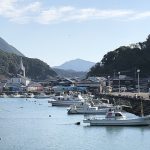 Today we make an exciting transition from the mainland Kyushu to Amakusa island. Amakusa, which is located at southwestern part of Kumamoto Prefecture, is an island group consisting of two major islands and 100 other islands varying in size. Amakusa is remote. This isolation allowed missionaries in the 16th century to convert a considerable percentage of inhabitants and even the local lord to Christianity before the religion was forbidden in the early Edo period during the 17th century. Today there are museums and churches spread across the islands which reflect this religious heritage.
Today we make an exciting transition from the mainland Kyushu to Amakusa island. Amakusa, which is located at southwestern part of Kumamoto Prefecture, is an island group consisting of two major islands and 100 other islands varying in size. Amakusa is remote. This isolation allowed missionaries in the 16th century to convert a considerable percentage of inhabitants and even the local lord to Christianity before the religion was forbidden in the early Edo period during the 17th century. Today there are museums and churches spread across the islands which reflect this religious heritage.
November 11, Thursday

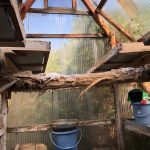 Today we visit a salt farm. We then have a pleasure easy-short walking up to the top of Tenjiku Mountain, and enjoy a picnic. We head to Takahama Porcelain Company and each of us makes our own glazing design on a bare previously baked mug. The mug will be fired and become a souvenir of your Kyushu adventure. Amakusa jiki, the raw material for Takahama porcelain, was discovered in this area in the 17th century. It is known for its pure whiteness and solid nature. The quality of the clay has been highly praised as the best porcelain clay in the world. It has been used for years to make the highest quality Japanese porcelain goods such as Arita-yaki (Arita ware) and Seto-yaki (Seto ware).
Today we visit a salt farm. We then have a pleasure easy-short walking up to the top of Tenjiku Mountain, and enjoy a picnic. We head to Takahama Porcelain Company and each of us makes our own glazing design on a bare previously baked mug. The mug will be fired and become a souvenir of your Kyushu adventure. Amakusa jiki, the raw material for Takahama porcelain, was discovered in this area in the 17th century. It is known for its pure whiteness and solid nature. The quality of the clay has been highly praised as the best porcelain clay in the world. It has been used for years to make the highest quality Japanese porcelain goods such as Arita-yaki (Arita ware) and Seto-yaki (Seto ware).
November 12, Friday

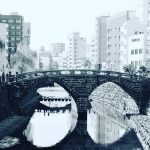 Today we say goodbye to Amakusa and head to Nagasaki by boat. We visit Kofukuji Temple, Obaku Zen temple. Kofukuji Temple dates to around 1620 when the merchants from China’s Ming Dynasty began to arrive in Nagasaki. A Chinese priest founded the temple to pray for safety in the perilous sea journey from China to Japan. We then head to Dejima Museum on foot. Dejima (“separated island”), the tiny man-made island just off the shore and connected by a foot bridge to Nagasaki, was constructed in 1636 and was used to house Dutch traders for 250 years during the Edo period (1600 – 1868) when Japan was closed to the outside world. The island itself disappeared with more reclamation of the land from Nagasaki Bay, but now island compound has been faithfully recreated as the Dejima Museum on its original, now a land-locked site. It is not Disneyland, but is a living, fascinating and accessible historical site replete with Japanese and Dutch history.
Today we say goodbye to Amakusa and head to Nagasaki by boat. We visit Kofukuji Temple, Obaku Zen temple. Kofukuji Temple dates to around 1620 when the merchants from China’s Ming Dynasty began to arrive in Nagasaki. A Chinese priest founded the temple to pray for safety in the perilous sea journey from China to Japan. We then head to Dejima Museum on foot. Dejima (“separated island”), the tiny man-made island just off the shore and connected by a foot bridge to Nagasaki, was constructed in 1636 and was used to house Dutch traders for 250 years during the Edo period (1600 – 1868) when Japan was closed to the outside world. The island itself disappeared with more reclamation of the land from Nagasaki Bay, but now island compound has been faithfully recreated as the Dejima Museum on its original, now a land-locked site. It is not Disneyland, but is a living, fascinating and accessible historical site replete with Japanese and Dutch history.
November 13, Saturday
Today our guide, a native of Nagasaki, takes the group to the must-see places in this historic city. These include Nagasaki Atomic Bomb Museum, Peace Park at “ground zero” and Uragami Church. She takes us to a soba lunch. After lunch the coach drives us to the Nagasaki station. You have free afternoon to discover the city own your own.
November 14, Sunday
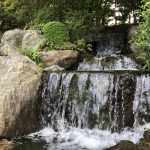 Today we leave for our final destination, Fukuoka, on the northwestern coast of Kyushu by train. Fukuoka is Kyushu’s largest and Japan’s 5th most populated city. Because of its closeness to the Asian mainland, Fukuoka has been an important harbor city for many centuries. We visit a Ohori park and enjoy a beautifully landscaped Japanese tea garden or visit Fukuoka Art Museum in the park. Fukuoka is a gourmet paradise…providing you are not a strict vegetarian. Motsu nabe (intestine and tripe hot pot), tori-suki (chicken hot pot) and very fresh seafood from the Genkai Sea are abundant. Fukuoka-style tonkotsu (pork bone-based broth) ramen is also unique & famous, and now popular in US ramen restaurants. There are yatai (outdoor food stalls) offering delicious, home-style comfort foods that are unusual elsewhere in Japan.
Today we leave for our final destination, Fukuoka, on the northwestern coast of Kyushu by train. Fukuoka is Kyushu’s largest and Japan’s 5th most populated city. Because of its closeness to the Asian mainland, Fukuoka has been an important harbor city for many centuries. We visit a Ohori park and enjoy a beautifully landscaped Japanese tea garden or visit Fukuoka Art Museum in the park. Fukuoka is a gourmet paradise…providing you are not a strict vegetarian. Motsu nabe (intestine and tripe hot pot), tori-suki (chicken hot pot) and very fresh seafood from the Genkai Sea are abundant. Fukuoka-style tonkotsu (pork bone-based broth) ramen is also unique & famous, and now popular in US ramen restaurants. There are yatai (outdoor food stalls) offering delicious, home-style comfort foods that are unusual elsewhere in Japan.
November 15, Monday
Tour dissolves after breakfast. Those who continue to post-tour locations or those who depart for home, have a safe and pleasant trip. Whatever your destinations the mug you created in Amakusa will meet you at the arranged place. Please cherish your Kyushu memories for the rest of your life!
Posted
on 8:12 PM
in Hiroko's Blog
My mother finally departed on September 29, 2020. She was a dedicated, joyful, open, hard-working and loving person. She enjoyed a full life in her 93 years on earth. Here is my mother’s story No. 2.
My Mom one day as she sat in his lap, watched her father gulping down a small glass of beer. She was 5 years old. Her father’s contented, big smile with some white beer foam attached around his moustache were so impressive that my Mom couldn’t stop watching him. Feeling his daughter’s intense curiosity her father jokingly asked my Mom if she wanted a taste. My Mom was the fourth girl among her 6 siblings with 2 younger brothers following her. She was born somewhat weak with some minor heart valve irregularity. She skipped all physical exercises during early school years because she didn’t have strength. Her pediatrician-father tried to find a way to improve her health. At that very moment on his lap Grandpa thought that perhaps the bitter tasting hops in the beer might do something good for my Mom. After tasing a tiny amount of his beer my Mom announced to her father that she loved the bitterness of the beer. After this first experiment how many more times did Granpa gave additional tastings of beer to my mother is in the clouds after a healthy 93 years? My Mom’s life turned one hundred eighty degrees in terms of comfort after she married my father. My Mom had grown up being completely taken care by her father, mother, her big sisters, and house maids. Especially after my father opened a medical clinic for surgery in a small hospital that was on the lower floor of our Tokyo home, my Mom had no choice but work almost non-stop, 365 days each year. This lasted for more than 30 years. My Mom’s day began early in the morning. First thing to do after getting up at 5:00 am was to meticulously sweep the street in front of our house with its attached surgical clinic. Then, she made breakfast for family members, live-in nurses and in-patients who stayed with us after having surgery. She managed the clinic, house and family all day long. Her busy day usually wound up at around midnight. She then spent next half hour at the dining table with all the newspapers of the day spread out in front of her. She read every page with a small can of beer by her side. I do not clearly remember but I think it was 250ml size. At the end of the day during which she had exhausted herself so much, she felt that the bitter flavor in the beer did something good to her and kept her going. I am sure her memory of that first tasting of beer and the love she received from her father were always with her at the end of the day. She continued enjoying beer into her 80s and then suddenly stopped. She told me, with a wink, that the beer is no longer tasty. But I think she simply decided that a person of her age should not consume alcohol. Indeed, after that at family affairs when everyone was enjoying beer, sake or wine, she would always enjoying a glass of water.
Posted
on 1:06 PM
in Hiroko's Blog

great sun setting; appreciation
The world has been dramatically changing under the Covid-19 pandemic. Once upon a time life was slower, more mellow, and gentler for me. I was a boomer. I begin to feel that I am a dinosaur. And my mother turned to 93 this year. She had health issues but was happy and in good spirits and had a healthy appetite until 6 weeks ago. She led her life even at her late age in the same way she has been doing for the adult part of her 93 years. This means that she did her daily chores, including washing the laundry, apartment cleaning (it is small space, though) and making meals four times a week. Shopping was no longer her chore and she missed it a lot. Luckily, she was living with my sister.
Suddenly her health declined and she was admitted to the hospital.
If I were asked right now with whom I wanted to have my last meal, my answer would be my mother. And I would add my Mom’s parents, my grandparents as well if they were still alive. Maybe this answer was driven by today’s Covid-19 situation that I, with an American passport, cannot easily visit Japan right now. Who I am, what I have accomplished in the past and what I am doing today is because I am the daughter of my mother and the granddaughter of her parents. So, I decided to post my food-and-my Mom memories before it gets too late. And here is the first entry.
- My Mother’s Story: Grandma Plucking Chicken and the Omelet
My Mom has always made everything taste delicious at our mealtimes. One of her favorite dishes to prepare when I was young was fried chicken, Tori no Kara-age. She loved this dish. This was before the 1970’s introduction of KFC (Kentucky Fried Chicken) to Japan. Tori no Kara-age is a dish in which marinated chicken is dusted with potato starch or flour and then deep-fried. The first dish of this kind appeared at a restaurant in Tokyo around 1932. It was a dish whose preparation techniques were adopted from the Chinese kitchen. At the dinner table with Tori no Kara-age my Mom often repeated the story of how she developed a taste for chicken.
My Mom’s parents lived in the town of Takada, in Niigata Prefecture, facing the Japan Sea and it was a strategic military port town in the past. My Grandpa was a rather well-to-do, highly respected pediatrician. In addition to his busy workday he served as the kindergarten doctor at a nearby church’s Sunday School. That church and school was operated by an American missionary, and my mother was a pupil in that kindergarten. My mother was never quite sure if the missionary couple was American or Canadian, but my Grandpa’s published poems which I read recently indicates that they were American. At their home Grandma took care of and fed over 30 people. This included her 6 children, live-in nurses and house maids. When my Mom came back from the school, she often found my Grandma plucking chickens one after another in the garden. She jumped for joy because she knew what the dinner would be that evening. Back then many patients who were too poor to pay my Grandpa in cash, paid with some of the foods they produced on their farms. Chickens and eggs happened to be the most welcomed and most frequent gifts at my Grandma’s home. After deboning the chickens Grandma made a huge pot of chicken stock with the bones together with onions and carrots. My Mom still remembers the aroma of that pot of chicken stock and the wonderful taste of the broth. The meat was cut into bite sized pieces and deep-fried in Tori no Kara-age style, her children’s favorite. Eggs were always reserved for her husband’s favorite omelet. My Grandma learned how to make a perfect omelet from the missionary’s wife, Martha. I am sure that precious and rare butter, which was always secured and carefully stored in small quantity at my Grandma’s kitchen, surely made the omelet taste authentic. My grandma died when my mother was just a teenager, so I did not have an opportunity to meet her. But, whenever I debone chicken and prepare chicken dishes, Gramdma’s image appears in my mind. I wish I could have known her.
 Hiroko’s Kitchen made it onto CulinaryPrograms.net’s recently completed list of 100 Magnificent Sites for Chefs.
Hiroko’s Kitchen made it onto CulinaryPrograms.net’s recently completed list of 100 Magnificent Sites for Chefs.

 Last week I Co-hosted with Ezra Star, a Cognac Expert, “Roll with Cognac”, educational webinar, for journalists. Pairing Cognac and Sushi – how fun and cool it was!
Last week I Co-hosted with Ezra Star, a Cognac Expert, “Roll with Cognac”, educational webinar, for journalists. Pairing Cognac and Sushi – how fun and cool it was!





 The year 2021 begins a new chapter in my teaching career. I will be offering cooking classes over Zoom starting in February 2021. Please have a look what I am offering and join me to learn how to prepare Japanese dishes both comfort food and more challenging ones with ease and fun. You will not just learn the recipe of the dish. You will learn techniques, preparation tips, personal anecdotes, interesting stories and the history of the dishes. The first session introduces you to and provides you with the absolute best wagyu beef from Japan and instruction in how to prepare it with accompanying dishes and to the fascinating process of making and using your own miso.
The year 2021 begins a new chapter in my teaching career. I will be offering cooking classes over Zoom starting in February 2021. Please have a look what I am offering and join me to learn how to prepare Japanese dishes both comfort food and more challenging ones with ease and fun. You will not just learn the recipe of the dish. You will learn techniques, preparation tips, personal anecdotes, interesting stories and the history of the dishes. The first session introduces you to and provides you with the absolute best wagyu beef from Japan and instruction in how to prepare it with accompanying dishes and to the fascinating process of making and using your own miso. We take an early morning flight to Oita Airport. We visit Kunisaki Peninsula, located in the northeast area of Kyushu, which is known for ancient, unique Buddhist culture. We participate in-a-once-in-a-life time Buddhist ritual service at Monju-Senji Temple, which was founded in 648 AD. The priest, tending a large ritual fire, prays for our health, family happiness and good weather & safe journey through out our tour. We stop at the Tennenji Temple, hike and admire Magaibutsu, Buddha sculptures carved into the rock cliff. We head to Beppu, one of the most famous hot spring towns in Japan for one-night stay. We enjoy fugu (blowfish) specialty dinner at 100 years old establishment in the town.
We take an early morning flight to Oita Airport. We visit Kunisaki Peninsula, located in the northeast area of Kyushu, which is known for ancient, unique Buddhist culture. We participate in-a-once-in-a-life time Buddhist ritual service at Monju-Senji Temple, which was founded in 648 AD. The priest, tending a large ritual fire, prays for our health, family happiness and good weather & safe journey through out our tour. We stop at the Tennenji Temple, hike and admire Magaibutsu, Buddha sculptures carved into the rock cliff. We head to Beppu, one of the most famous hot spring towns in Japan for one-night stay. We enjoy fugu (blowfish) specialty dinner at 100 years old establishment in the town.
 Today we head to 290 years old Kurokawa Onsen, a hot spring town that has 30 traditional Japanese inns, equipped with rotenburo (outdoor hot spring), scattered deeply in natural beauty alongside the Tanohata River. We stop at Kokonoe Yume Otsurihashi, the highest suspention bridge only for walkway built in in 2006. The beautiful nature is 360 degree view. After arriving we experience Outdoor Onsen-Hopping. We also enjoy local specialty Sake/Shochu-Hopping. The charming inn which we stay for two nights is closed for our group. We enjoy meals prepared with local ingredients.
Today we head to 290 years old Kurokawa Onsen, a hot spring town that has 30 traditional Japanese inns, equipped with rotenburo (outdoor hot spring), scattered deeply in natural beauty alongside the Tanohata River. We stop at Kokonoe Yume Otsurihashi, the highest suspention bridge only for walkway built in in 2006. The beautiful nature is 360 degree view. After arriving we experience Outdoor Onsen-Hopping. We also enjoy local specialty Sake/Shochu-Hopping. The charming inn which we stay for two nights is closed for our group. We enjoy meals prepared with local ingredients.

 This morning at the historic town of Hitoyoshi we take a man-poled boat ride down the Kuma River, which boasts of having the 2nd most rapid current in Japan. The same ride in the same kind of craft the local Daimyo, Aira, took in feudal days to go down-river in order to begin his biannual trip to Edo (present Tokyo) to pay his respects and tribute to the Shogun. After lunch our coach takes us to Onami-Ike, a beautiful crater lake which stands at 1,411 meters (4,500 feet) above sea level. Onami-Ike Crater Lake was the product of a volcano eruption about 40,000 years ago. The water is cobalt blue. We enjoy walking on a trail through the woods to the top of the Onami-Ike to admire the beautiful lake. After the walk we head to two nights stay at a new, relaxing accommodation.
This morning at the historic town of Hitoyoshi we take a man-poled boat ride down the Kuma River, which boasts of having the 2nd most rapid current in Japan. The same ride in the same kind of craft the local Daimyo, Aira, took in feudal days to go down-river in order to begin his biannual trip to Edo (present Tokyo) to pay his respects and tribute to the Shogun. After lunch our coach takes us to Onami-Ike, a beautiful crater lake which stands at 1,411 meters (4,500 feet) above sea level. Onami-Ike Crater Lake was the product of a volcano eruption about 40,000 years ago. The water is cobalt blue. We enjoy walking on a trail through the woods to the top of the Onami-Ike to admire the beautiful lake. After the walk we head to two nights stay at a new, relaxing accommodation.
 Today we head down to the prefecture where the most indispensable Japanese food product is produced. It is katsuobushi (stone-hard, dried, smoked skipjack tuna). The infusion of katsuobushi and kombu (kelp) makes dashi stock, the foundation of Japanese cuisine. We visit the Matoba katsuobushi plant and learn and see the fascinating traditional, artisanal production of katsuobushi. We then visit award winning, family owned, small shochu brewery, Yoshinaga Shuzo, established in 1905. Even the bottling and labeling are done manually at this artisanal shochu producer. And, of course, we taste varieties of their products and you can purchase a bottle or two to take home.
Today we head down to the prefecture where the most indispensable Japanese food product is produced. It is katsuobushi (stone-hard, dried, smoked skipjack tuna). The infusion of katsuobushi and kombu (kelp) makes dashi stock, the foundation of Japanese cuisine. We visit the Matoba katsuobushi plant and learn and see the fascinating traditional, artisanal production of katsuobushi. We then visit award winning, family owned, small shochu brewery, Yoshinaga Shuzo, established in 1905. Even the bottling and labeling are done manually at this artisanal shochu producer. And, of course, we taste varieties of their products and you can purchase a bottle or two to take home. Today we make an exciting transition from the mainland Kyushu to Amakusa island. Amakusa, which is located at southwestern part of Kumamoto Prefecture, is an island group consisting of two major islands and 100 other islands varying in size. Amakusa is remote. This isolation allowed missionaries in the 16th century to convert a considerable percentage of inhabitants and even the local lord to Christianity before the religion was forbidden in the early Edo period during the 17th century. Today there are museums and churches spread across the islands which reflect this religious heritage.
Today we make an exciting transition from the mainland Kyushu to Amakusa island. Amakusa, which is located at southwestern part of Kumamoto Prefecture, is an island group consisting of two major islands and 100 other islands varying in size. Amakusa is remote. This isolation allowed missionaries in the 16th century to convert a considerable percentage of inhabitants and even the local lord to Christianity before the religion was forbidden in the early Edo period during the 17th century. Today there are museums and churches spread across the islands which reflect this religious heritage.
 Today we visit a salt farm. We then have a pleasure easy-short walking up to the top of Tenjiku Mountain, and enjoy a picnic. We head to Takahama Porcelain Company and each of us makes our own glazing design on a bare previously baked mug. The mug will be fired and become a souvenir of your Kyushu adventure. Amakusa jiki, the raw material for Takahama porcelain, was discovered in this area in the 17th century. It is known for its pure whiteness and solid nature. The quality of the clay has been highly praised as the best porcelain clay in the world. It has been used for years to make the highest quality Japanese porcelain goods such as Arita-yaki (Arita ware) and Seto-yaki (Seto ware).
Today we visit a salt farm. We then have a pleasure easy-short walking up to the top of Tenjiku Mountain, and enjoy a picnic. We head to Takahama Porcelain Company and each of us makes our own glazing design on a bare previously baked mug. The mug will be fired and become a souvenir of your Kyushu adventure. Amakusa jiki, the raw material for Takahama porcelain, was discovered in this area in the 17th century. It is known for its pure whiteness and solid nature. The quality of the clay has been highly praised as the best porcelain clay in the world. It has been used for years to make the highest quality Japanese porcelain goods such as Arita-yaki (Arita ware) and Seto-yaki (Seto ware).
 Today we say goodbye to Amakusa and head to Nagasaki by boat. We visit Kofukuji Temple, Obaku Zen temple. Kofukuji Temple dates to around 1620 when the merchants from China’s Ming Dynasty began to arrive in Nagasaki. A Chinese priest founded the temple to pray for safety in the perilous sea journey from China to Japan. We then head to Dejima Museum on foot. Dejima (“separated island”), the tiny man-made island just off the shore and connected by a foot bridge to Nagasaki, was constructed in 1636 and was used to house Dutch traders for 250 years during the Edo period (1600 – 1868) when Japan was closed to the outside world. The island itself disappeared with more reclamation of the land from Nagasaki Bay, but now island compound has been faithfully recreated as the Dejima Museum on its original, now a land-locked site. It is not Disneyland, but is a living, fascinating and accessible historical site replete with Japanese and Dutch history.
Today we say goodbye to Amakusa and head to Nagasaki by boat. We visit Kofukuji Temple, Obaku Zen temple. Kofukuji Temple dates to around 1620 when the merchants from China’s Ming Dynasty began to arrive in Nagasaki. A Chinese priest founded the temple to pray for safety in the perilous sea journey from China to Japan. We then head to Dejima Museum on foot. Dejima (“separated island”), the tiny man-made island just off the shore and connected by a foot bridge to Nagasaki, was constructed in 1636 and was used to house Dutch traders for 250 years during the Edo period (1600 – 1868) when Japan was closed to the outside world. The island itself disappeared with more reclamation of the land from Nagasaki Bay, but now island compound has been faithfully recreated as the Dejima Museum on its original, now a land-locked site. It is not Disneyland, but is a living, fascinating and accessible historical site replete with Japanese and Dutch history. Today we leave for our final destination, Fukuoka, on the northwestern coast of Kyushu by train. Fukuoka is Kyushu’s largest and Japan’s 5th most populated city. Because of its closeness to the Asian mainland, Fukuoka has been an important harbor city for many centuries. We visit a Ohori park and enjoy a beautifully landscaped Japanese tea garden or visit Fukuoka Art Museum in the park. Fukuoka is a gourmet paradise…providing you are not a strict vegetarian. Motsu nabe (intestine and tripe hot pot), tori-suki (chicken hot pot) and very fresh seafood from the Genkai Sea are abundant. Fukuoka-style tonkotsu (pork bone-based broth) ramen is also unique & famous, and now popular in US ramen restaurants. There are yatai (outdoor food stalls) offering delicious, home-style comfort foods that are unusual elsewhere in Japan.
Today we leave for our final destination, Fukuoka, on the northwestern coast of Kyushu by train. Fukuoka is Kyushu’s largest and Japan’s 5th most populated city. Because of its closeness to the Asian mainland, Fukuoka has been an important harbor city for many centuries. We visit a Ohori park and enjoy a beautifully landscaped Japanese tea garden or visit Fukuoka Art Museum in the park. Fukuoka is a gourmet paradise…providing you are not a strict vegetarian. Motsu nabe (intestine and tripe hot pot), tori-suki (chicken hot pot) and very fresh seafood from the Genkai Sea are abundant. Fukuoka-style tonkotsu (pork bone-based broth) ramen is also unique & famous, and now popular in US ramen restaurants. There are yatai (outdoor food stalls) offering delicious, home-style comfort foods that are unusual elsewhere in Japan.